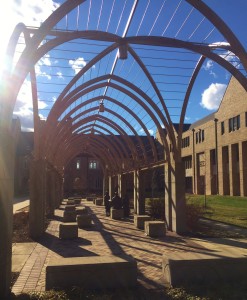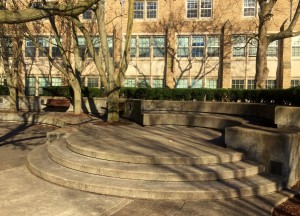As the weather gets warmer, it’s a refrain heard by many teachers: “Can we have class outside?” Though some have visions of passionate philosophical debates being held under the shade of the old oak tree, in reality, it is a question often fraught with concerns about the weather and any number of distractions that might impede the lesson plan for the day. On the other hand, maybe acquiescing once won’t hurt anything, and may end up giving a nice bump to those teaching evaluations. What’s a TA or instructor to do when approached with this question? Here are the pros and cons of teaching outdoors, as well as some suggestions to consider when doing so.
The Concerns:

A popular outdoor classroom location between DeBartolo Hall and the Law School
- Distractions. There are plenty of distractions within the classroom, and even more outside of it. Your lesson for the day will be competing with other students walking past, construction noise, bugs and animals, and other conversations. It will also take up additional class time to find and move to the right location.
- Weather. While it may look beautiful out the window, sitting in one place outside can be too hot/cold for some students, and it can be difficult to find a space with the right amount of sun or shade. The wind can whip papers around, and then there’s always the chance for passing rain (or snow, for that matter). Plus, weather changes sometimes lead to allergies, which can make for an uncomfortable out-of-the-classroom experience.
- (Lack of) Resources. The convenience of a classroom is that it has most everything needed to conduct a class session. On the other hand, taking your class outdoors likely means no computer, whiteboard, or desks for students to take notes. Some classes, like lab sciences, rely even more on classroom space to fulfill daily learning activities.
The Defense:
- It’s Healthy. In a world of “nature deficit disorder,” it is easy to be cramped up indoors all day without a chance to see the sun and breathe the fresh air.[1] Particularly so for busy college students and professors. Getting outdoors, even for a short while, can improve health and well-being and help one recover from mental fatigue.
- Motivation. Holding class outside offers a change of pace from the normal routine: a chance to reinvigorate the subject and increase students’ motivation to learn. A new environment adds excitement to discussions, and may actually improve student concentration.
- (New) Resources. Teaching class without PowerPoint or immobile desks allows one to incorporate different active learning techniques that might not be practical in the classroom. For instance, the additional space presents an opportunity for easy small group discussions, group work, or other activities that require movement. With some creativity, you may also be able to tie the environment to your subject or lesson plan for the day.
Things to Consider

Seating outside of O’Shaughnessy Hall
- Is there a space that is available with enough (clean) seating for the students? Will everyone be able to see and hear what is going on? What distractions will you be competing with?
- Are all students properly prepared to hold class outside? If students aren’t expecting to be outdoors for an extended period of time, they may not have warm enough clothing to be comfortable for the entire class period. If you are planning to have class outside, consider telling students to come prepared to the next class or email them the night before to let them know it is a possibility. Try to get a sense from all students how they feel about having class outside, not just those asking.
- Don’t throw out your best teaching practices! Just because you are outdoors doesn’t mean your lesson plan has to go out the door too (except to accompany you to your learning space). Stick to your agenda by identifying learning goals for the day and having a beginning, middle, and end to the class.
Additional Reading
- Ask Professor Pedagogy: Holding Class Outside
- “My Nomadic Class” by Thomas Fisher
- “Vitalizing Effects of Being Outdoors and in Nature” by Richard M. Ryan et al.
- “Views to Nature: Effects on Attention” by Carolyn M. Tennessen & Bernadine Cimprich
- “Exposure to Restorative Environments Helps Restore Attentional Capacity” by Rita Berto
________
[1] Last Child in the Woods: Saving Our Children from Nature-Deficit Disorder by Richard Louv
